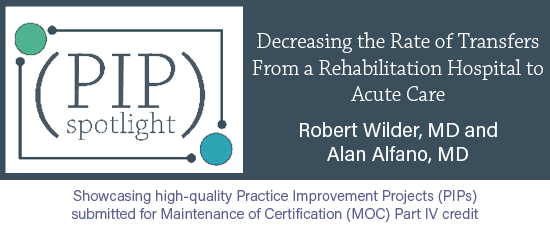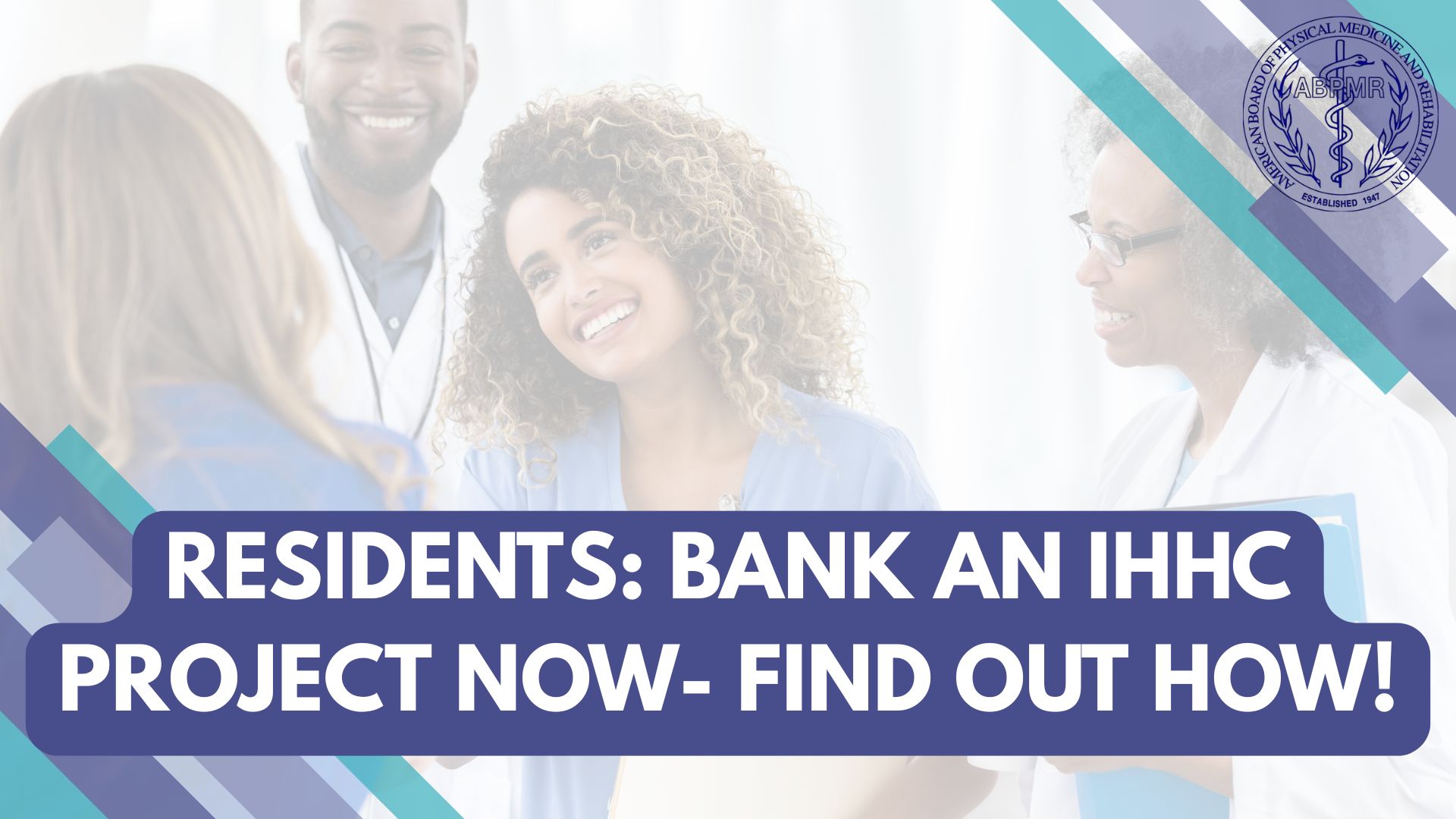CC
PIP Spotlight: Decreasing the Rate of Transfers From a Rehabilitation Hospital to Acute Care

Robert Wilder, MD, and Alan Alfano, MD, each submitted this Practice Improvement Project (PIP) after analyzing the acute care transfer (ACT) rate at their rehabilitation hospital and taking steps to decrease the number of transfers.
Although the project fell just short of its goal, Dr. Wilder reported that the protocols that were put into practice did result in a marked decrease in the ACT rate and that their plan would continue to be utilized.
Thank you to both Dr. Wilder and Dr. Alfano for submitting this PIP and for demonstrating that the same project can be submitted separately by more than one physician for PIP credit, as long as each diplomate is able to explain his or her contributing role.
The PIP Spotlight is a periodic feature on News Center to highlight exemplary Practice Improvement Projects submitted by your fellow diplomates (or residents) for maintenance of certification (MOC) Part IV credit. Diplomates can use the PIP Spotlight as a tool to model additional PIPs or as a way to connect with other diplomates doing similar work.

What is the problem you are trying to solve?
The quarterly acute care transfer (ACT) rate at our rehabilitation hospital was 13-17% for over the five years prior to implementing this formal improvement process. Most importantly, it is recognized that the decreases in medical status necessitating transfer were detrimental to the patient. Additionally, the ACTs can contribute to other negative outcomes including:
- Disruption to rehabilitative progress
- Increase in medical risks associated with handoff of care that could negatively impact overall care
- Increased burden on the main hospital by limiting bed availability for other patients
- Increased costs
What data (objective measurements) do you have that supports this as a problem?
Prior to the implementation of this project, the five-year ACT rate for our rehabilitation hospital was 13-15% and quarterly rates were as high as 17%.
What is your opportunity statement? State the goal you hope to achieve.
Our goal was to reduce the ACT rate from 13-15% to 10% in one year.
What is the underlying cause of the performance/quality problem?
The contributors to the high ACT rate were multifactorial, including:
- Inadequate communication between primary care team and receiving care team (including varying availability of discharge summaries and medication reconciliation)
- Lack of timeliness and accuracy of assessment of readiness for inpatient rehabilitation
- Inadequate use of the PM&R consultative physician team at the main medical center
- Limited availability of medicine and subspecialty consultative services at the rehabilitation hospital
- Limited ability and comfort level of nurses and physicians to manage increasingly medically complex patients at the rehabilitation hospital
- Lack of formal nursing protocols for addressing high-risk conditions such as transplantation, respiratory failure, congestive heart failure, and stroke
- Limited communication between care teams following an ACT limits efficiency in returning patient in a timely fashion
Determination of causes included regular meetings of our ACT team to discuss potential contributors as well as discussions at the weekly ACT review sessions which allowed a special window into contributors in each individual ACT case.

What change(s) did you implement?
Several interventions areas were targeted, including:
- Improved screening of potential patients for readiness for rehabilitation
- Improving communication, especially centering on the handoff of care
- Ensuring completion of necessary medical records and documentation including discharge summaries
- Medication reconciliation
- Early identification of, and intervention for, medical changes in the rehabilitation hospital
- Actions to permit an expedient return to the rehabilitation hospital when medically stable
New procedures and systems:
- A weekly meeting to review all cases of ACT was established. These meetings have provided for ongoing process improvement through case-by-case review.
- Daily meetings of the physician consultation service and the nurse liaison team to discuss patients who have been identified as candidates for inpatient rehabilitation.
- A medical checklist to ensure provision of specific up-to-date information regarding medical stability for all patients presented for potential admission.
- Expectations for communication between the discharging and admitting physicians to ensure a complete and safe handoff of care.
- Daily "huddles" involving each member of the care team to review patient status and plan for the day.
- "MEWS" (Medical Early Warning System) to give all staff and visitors the ability to address changes in medical status quickly.
- The ReACT algorithm, an electronic medical record (EMR)—based system developed by UVA-HealthSouth Rehabilitation Hospital to evaluate several clinical variables that have been determined to increase the ACT rate.
- Requirement of attending physician phone calls within 24 hours of an ACT. This allowed for collaboration in care and preparation for an expedient return to rehabilitation when appropriate. This proved especially helpful for Medicare patients who were able to return prior to three days and thus not count as an ACT.

Did you achieve your goal or target from your opportunity statement? What data do you have to support your conclusion?
Our goal was to reduce the ACT rate to 10% in one year. Although we did not quite achieve this goal, we did demonstrate improvements and we continue to do so.
ACT rate:
- 16% for last two quarters of 2015
- 10.8% in 2016
- 10.7% in 2017
- 10.7% in 1st quarter of 2018
- 9.4% in 2nd quarter of 2018
We attribute the steady decline to our process which has included the implementation of different interventions over time as we continuously re-evaluate our efforts to decrease the ACT rate.
Our timeline for above listed interventions includes the following:
- Dec 2015: Launch project by creating our core group and initiating our own brainstorming process
- Jan 2016: Weekly ACT meetings commence
- Jan 2016: Physician-to-physician handoffs start
- Jan 2016: Daily meetings between consult service and nurse liaison group
- Spring 2016: Regular internal medicine consult coverage provided by internal medicine chief residents
- July 2016: Daily medicine consultation provided by outside contracted service
- Dec 2016: Physician-to-physician calls to facilitate transfer back to rehabilitation hospital in a timely fashion, particularly within three days for Medicare patients when reasonable

Will you continue with the changes you have implemented?
We will continue with the measures described above.
The weekly ACT meetings continue to be an opportunity to improve processes and patient care on a case-by-case basis, but also provide a venue to discuss ideas proposed by our care team. Communication between our rehabilitative care team and the medical center is crucial and the physician-to-physician communications will continue.
In September of this year, we launched the Medical Early Warning System (MEWS) allowing for any staff or visitor to report clinical changes and have them quickly addressed. We expect that this will facilitate early intervention and, in some cases, prevent the need for ACT.
We have recently incorporated the ReACT algorithm, a system for monitoring several variables associated with a higher rate of ACT and establishing a risk level for each patient for ACT. These are discussed in daily care team huddles and addressed appropriately. We are hopeful that this will improve clinical care and reduce ACTs.



